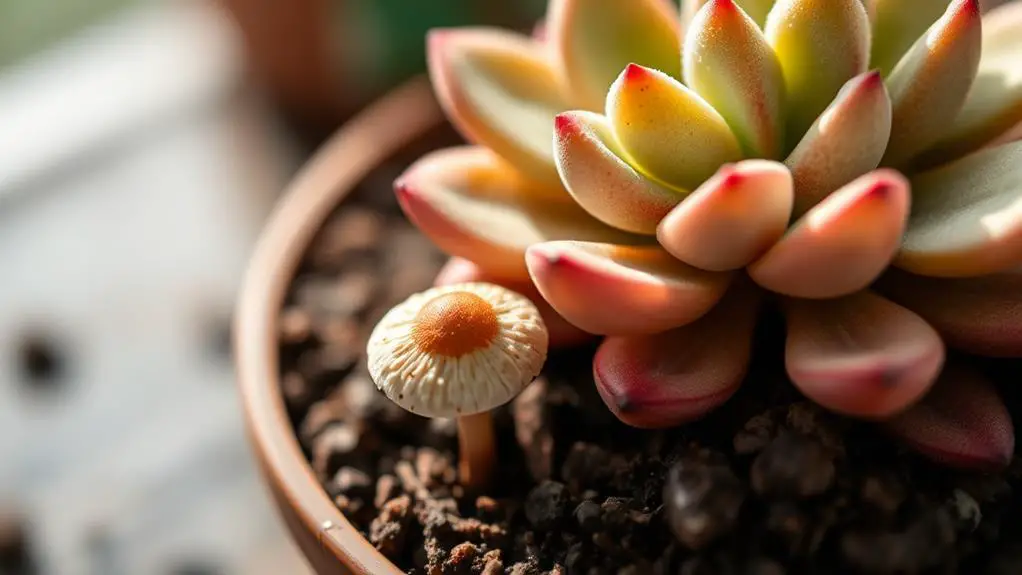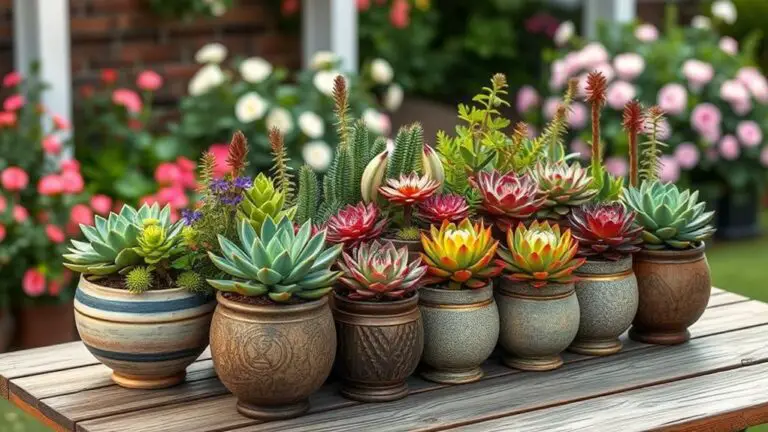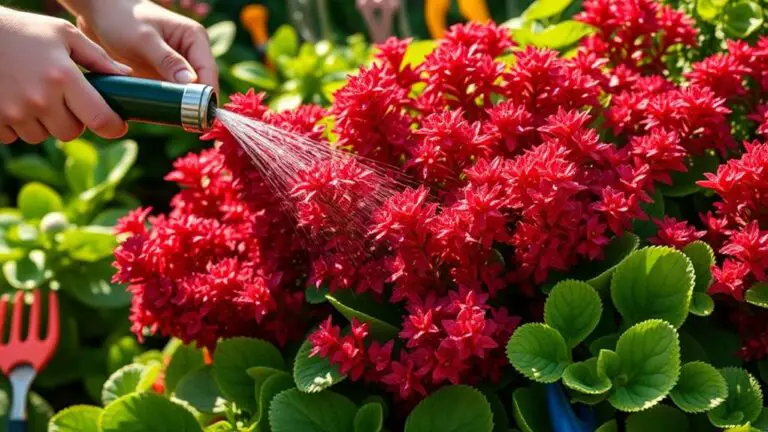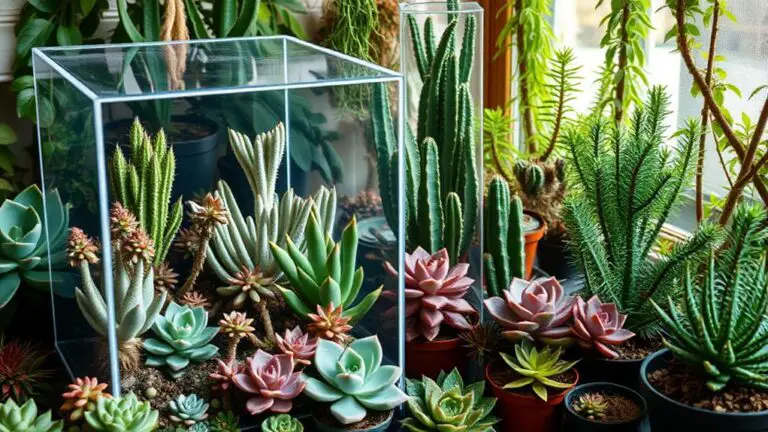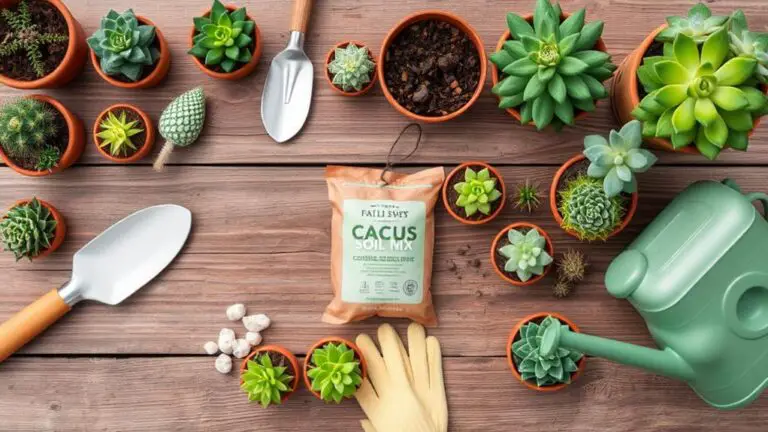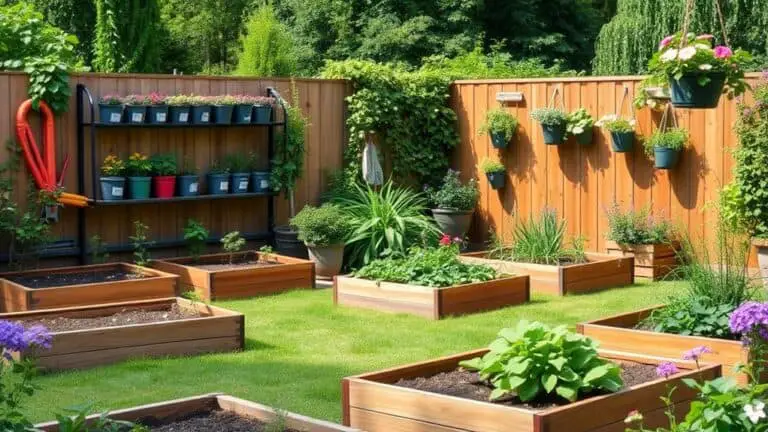Why Is There a Mushroom Growing in My Succulent Pot?
You might be puzzled to find a mushroom sprouting in your succulent pot, but it's a more common issue than you'd think. This unexpected guest often points to excess moisture, which could stem from overwatering or poor drainage. Mushrooms, like the toxic Leucocoprinus birnbaumii, thrive in these conditions and can signal deeper problems such as root rot and nutrient competition. Understanding why this happens is key to taking preventive measures and ensuring your succulent stays healthy. So, what exactly causes these fungi to emerge, and how can you stop them?
Causes of Mushroom Growth
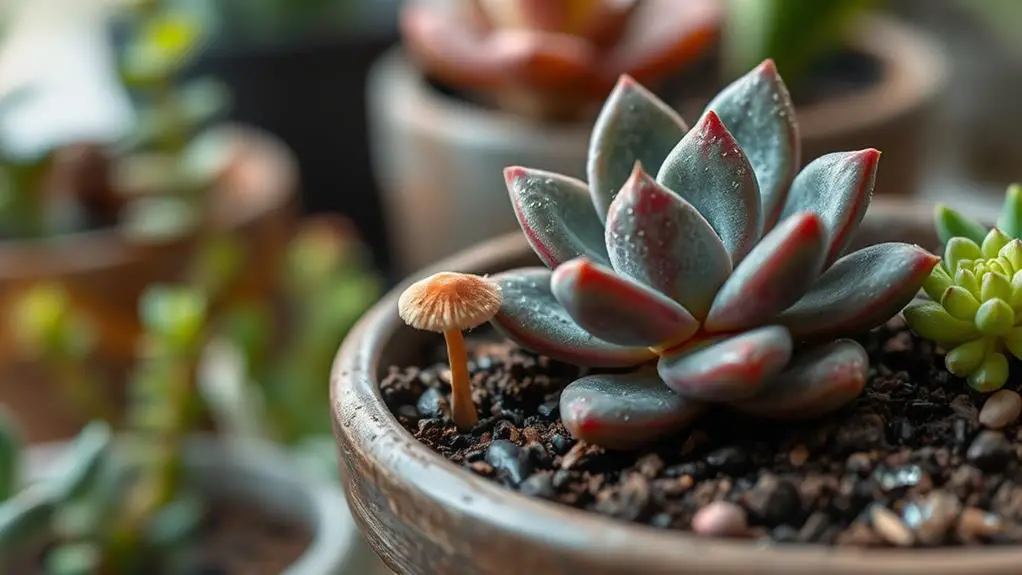
Mushrooms in your succulent pot often signal excess moisture in the soil, creating damp conditions ideal for fungal growth. When the soil holds too much water, it becomes a perfect environment for mushrooms to thrive. This can happen if your pot has poor drainage, trapping water and encouraging mushroom growth.
Another factor is the presence of organic matter. Decomposing leaves or composted materials in your potting mix can attract mushrooms. They feed on this organic material, leading to their appearance in your succulent pots.
It's crucial to use a well-draining potting mix designed for succulents to avoid this issue. Contaminated soil or potting mix is also a common cause. Sometimes, the soil or mix you use might've dormant fungal spores.
When conditions become suitable, like with high humidity and warm temperatures, these spores can sprout into mushrooms. Ensuring your potting mix is clean and free from contaminants can help prevent this problem.
To avoid excess moisture, make sure your pots have proper drainage holes and avoid overwatering. By maintaining the right soil conditions and using quality potting mix, you can minimize the risk of mushroom growth in your succulent pots.
Common Mushroom Types
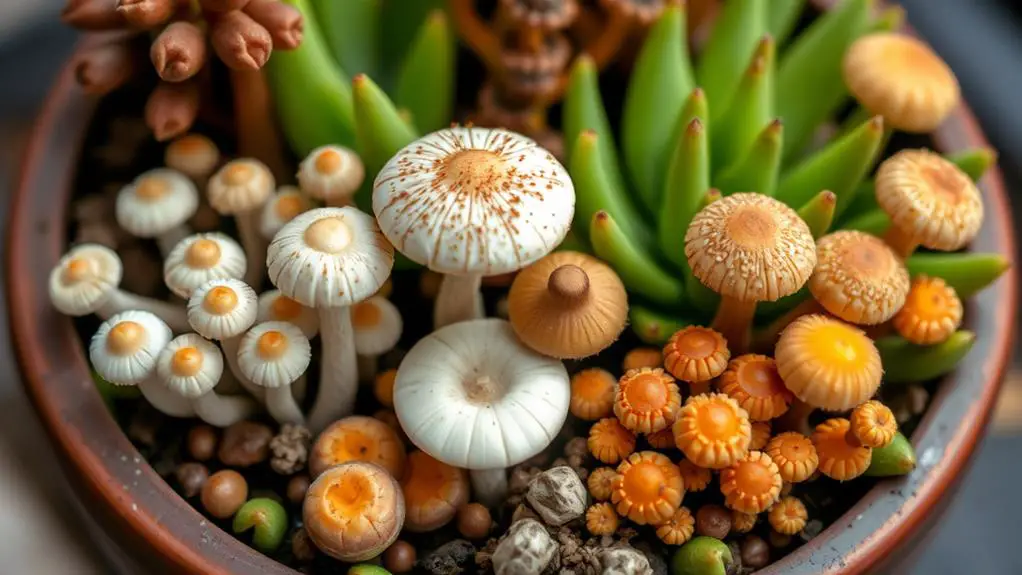
Understanding the causes of mushroom growth in your succulent pot sets the stage for recognizing the common types you might encounter. One common mushroom type you might find is Leucocoprinus birnbaumii, also known as the Flowerpot Parasol. It's easy to spot with its bright lemon-yellow color and height of 1-3 inches. These mushrooms growing in your potting soil are saprophytic, meaning they break down organic matter in the soil, contributing to nutrient cycling.
While Leucocoprinus birnbaumii isn't harmful to succulents, it's toxic if ingested. So, be cautious if you have pets or children around. These mushrooms thrive in warm, humid conditions, often appearing more during summer months when you might accidentally overwater your succulents.
Here's a quick table to help you identify Leucocoprinus birnbaumii and understand its characteristics:
| Mushroom Type | Characteristics |
|---|---|
| Leucocoprinus birnbaumii | Bright lemon-yellow color, 1-3 inches tall |
| Habitat | Warm, humid conditions, especially in summer |
| Soil Role | Saprophytic, breaks down organic matter |
Recognizing these mushrooms in your soil can indicate a healthy ecosystem. Many fungi help plants absorb nutrients, so seeing them in your potting soil isn't always a bad thing. Just keep an eye out and manage moisture levels to maintain balance.
Impact on Succulents
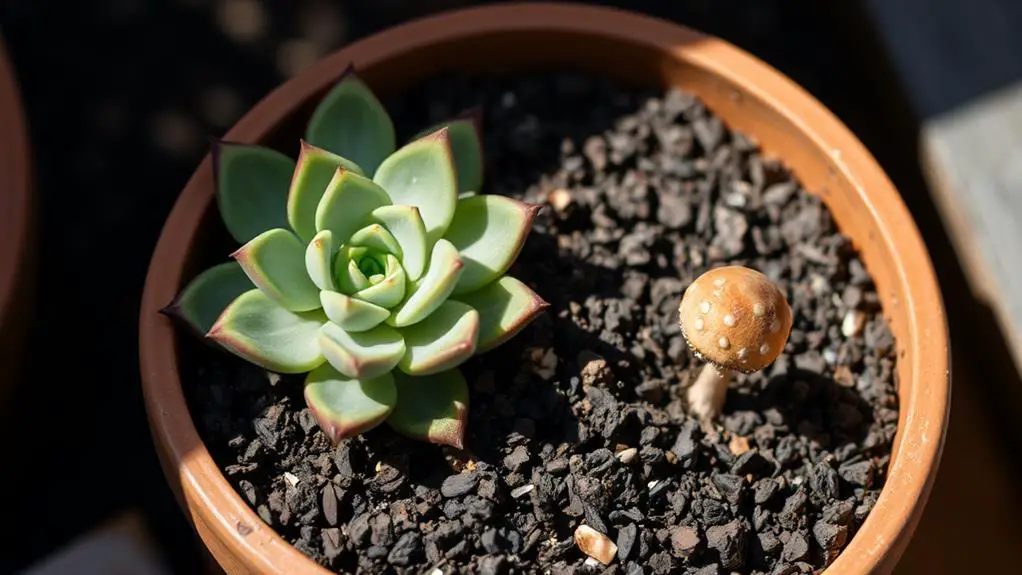
Seeing mushrooms in your succulent pot can be a warning sign.
They often mean there's too much moisture, which can lead to root rot and make your succulent sick.
Keep an eye on soil moisture and adjust your watering habits to protect your plant's health.
Fungal Infection Signs
Fungal infections in succulents can be a serious issue, often starting with subtle signs like wilting leaves, leaf spots, and discoloration, particularly on new growth. If you notice these symptoms, it's vital to act quickly.
Fungal infections thrive in moist environments, so monitoring soil moisture is important. When mushrooms appear in your succulent pot, it usually means the soil is too wet, which can lead to root rot.
Root rot is particularly damaging as it affects the succulent's delicate root system. You'll see symptoms like yellowing leaves or drooping, which indicate the plant is struggling. Succulents are adapted to dry conditions, so excessive moisture can compromise their health, making them more susceptible to fungal infections.
To prevent these issues, guarantee your succulent's soil has good drainage and avoid overwatering. Use a well-draining potting mix and let the soil dry out between waterings.
Early detection of fungal infection signs can save your succulent from extensive damage. Check your plants regularly, looking for any changes in leaf color or texture.
Root Rot Risks
When excess moisture lingers in your succulent's soil, root rot becomes a significant risk that can severely impact the plant's health.
Root rot is a common fungal disease that attacks the delicate root systems of succulents. This can prevent them from absorbing nutrients and water effectively. You might see symptoms like yellowing leaves, drooping plants, and a general decline in your succulent's health. These signs are your plant's way of telling you that it's struggling with too much moisture.
Long-term exposure to moist soil can do more than just harm your succulent now; it can actually shorten its lifespan if you don't take action. Early intervention is vital. You need to adjust your watering practices and guarantee proper drainage.
Start by checking the potting situation. Is your pot draining well? If not, consider getting rid of any excess water and repotting your succulent in a pot with better drainage.
Getting rid of root rot also means being mindful of how much water your succulent really needs. Remember, succulents thrive on less frequent watering. By making these changes, you'll help your succulent bounce back and stay healthy.
Nutrient Competition
Mushroom growth in your succulent pot can lead to significant nutrient competition, putting your plants at a disadvantage.
When mushrooms grow excessively, they can compete with your succulents for water and essential nutrients. This competition can deprive your succulents of what they need to thrive, especially in overly moist conditions.
The presence of mushrooms often signals an imbalance in soil health. This imbalance can make it harder for your succulents to get the nutrients they need. High levels of organic matter in the soil can encourage both mushroom growth and nutrient competition.
It's important to monitor and adjust the soil components to maintain a healthy balance.
To reduce nutrient competition, verify your succulent pot has proper drainage. This helps prevent overly moist conditions that favor mushroom growth.
Adjust your watering practices as well. Over-watering can lead to excessive mushroom growth, which in turn can outcompete your succulents for nutrients.
Soil Conditions
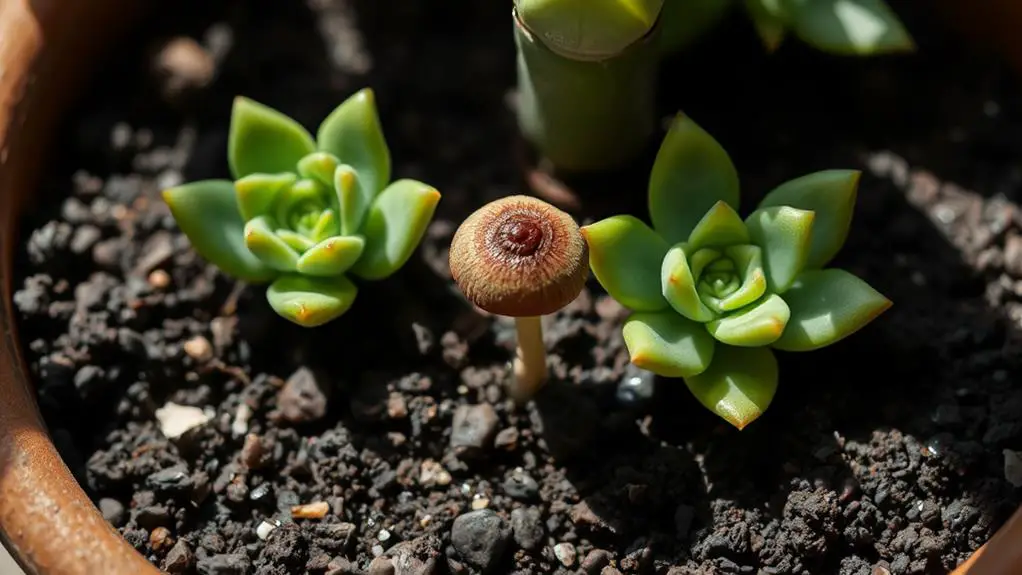
To tackle mushroom growth in your succulent pot, it's important to understand soil conditions.
Excess moisture from overwatering can create the perfect environment for mushrooms, especially if your soil contains organic matter like compost.
Make sure to use a well-draining soil mix and let the top layer dry out between waterings to keep moisture levels in check and prevent fungal growth.
Excess Soil Moisture
Excess soil moisture is the primary culprit for mushroom growth in succulent pots. When you overwater your succulents or use soil that doesn't drain well, you create an environment that's perfect for mushrooms. They thrive in damp conditions, which unfortunately can be harmful to your succulents.
Succulents need well-draining soil to avoid water buildup, as too much moisture can cause root rot and weaken your plants. To prevent this, make certain you're using the right kind of soil. Well-draining soil helps water flow through quickly, so it doesn't sit around the roots.
Also, let the top layer of soil dry out completely between waterings. This simple step can make a big difference in keeping both your succulents and any unwanted mushrooms at bay.
Additionally, check the drainage holes in your pots. Verify they aren't blocked, allowing excess water to escape easily. Good airflow around your plants also helps reduce moisture levels.
Organic Material Presence
The soil conditions in your succulent pot play a significant role in mushroom growth. When the soil contains organic materials like decomposing leaves or compost, it creates an environment where mushrooms can thrive. These organic materials hold onto moisture, which is perfect for fungal growth.
If you see mushrooms, it often means there's unprocessed organic matter in the soil. This material retains moisture, leading to a damp environment that mushrooms love. Soil rich in organic content can keep too much moisture, causing mushrooms to appear.
Incomplete composting processes can also introduce fungal spores into the soil, making it easy for mushrooms to grow when conditions are right.
To prevent this, try limiting the amount of organic material in your potting mix. Using a mix with less organic content can help reduce moisture retention and minimize fungal growth.
Proper Drainage Importance
When it comes to keeping your succulents healthy, proper drainage is absolutely essential. Without it, excess moisture can accumulate, leading to mushroom growth and root rot. To prevent this, you need to use well-draining soil, which typically includes materials like perlite or coarse sand. These help water move through the soil quickly, so it doesn't stick around long enough to cause problems.
Succulents prefer their soil to dry out completely between waterings. This drying period reduces the chances of mushrooms sprouting in your pot. Make certain your pots have drainage holes at the bottom. These holes let excess water escape, keeping the environment dry and suitable for succulents.
It's also a good idea to check that these drainage pathways stay clear. Regularly inspecting and maintaining them can prevent blockages that might trap water and lead to fungal issues.
Prevention Strategies
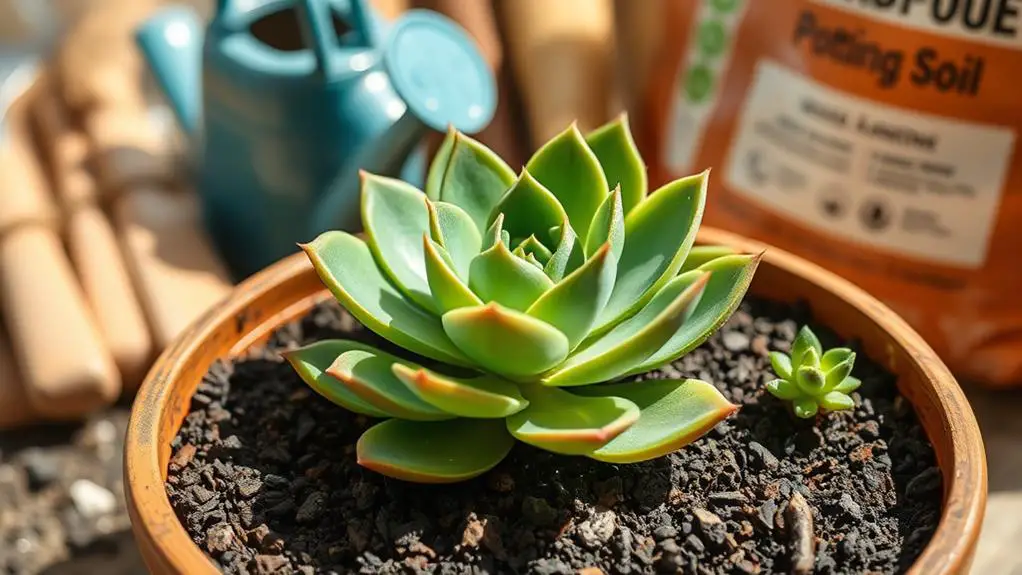
To prevent mushrooms from sprouting in your succulent pots, start by guaranteeing proper drainage. Use well-draining soil mixes and pots with adequate drainage holes. This stops water from accumulating and creates an environment where mushrooms can't thrive. Water only when the top inch of soil is dry to the touch. Overwatering leads to damp conditions, which mushrooms love.
Good airflow is also essential. Space your succulents apart and avoid overcrowding. This reduces humidity levels around the plants and makes it harder for mushrooms to grow. Regularly inspect your plants and soil for signs of excess moisture or decay. Catching problems early allows you to adjust your care routine and prevent mushrooms from emerging.
| Problem | Solution |
|---|---|
| Overwatering | Water only when soil is dry |
| Poor Drainage | Use pots with drainage holes |
| High Humidity | Guarantee good airflow |
Limiting the amount of organic matter in your potting mix can also help. Decomposing materials attract mushrooms and promote fungal growth, so less is more. By following these steps, you'll create a healthier environment for your succulents and keep those pesky mushrooms at bay.
Removal Techniques
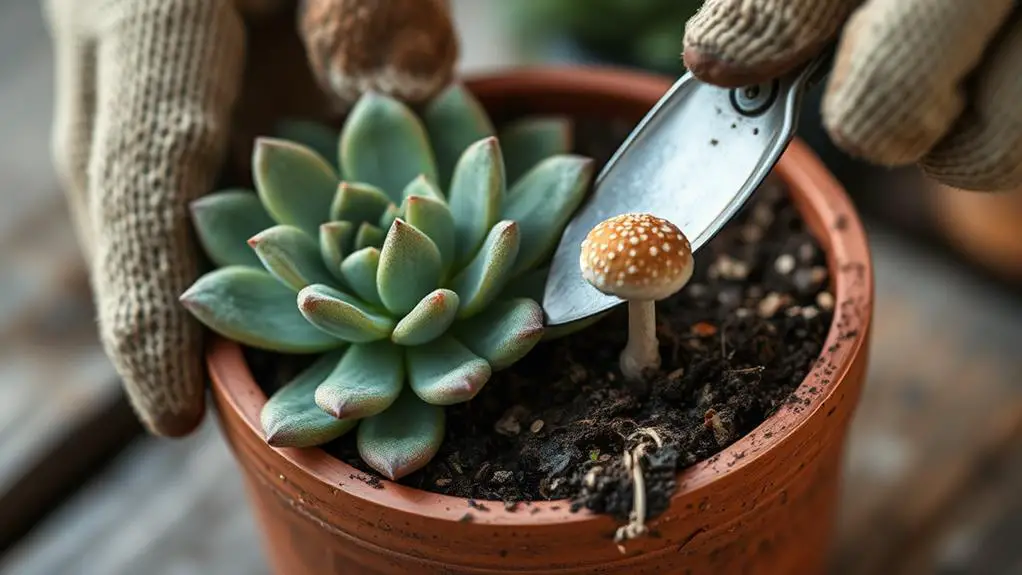
To start removing mushrooms from your succulent pot, gently grasp each mushroom at its base and twist it out to minimize soil disturbance.
You might also want to replace the top 2 inches of soil to help prevent spores from regrowing.
After removing the mushrooms, wipe away any residue with a damp cloth to keep everything clean and reduce the chance of new growth.
Manual Mushroom Removal
Gently twisting and pulling mushrooms from the soil at their base is an effective way to remove them, minimizing spore dispersal and preventing further growth.
Always wear gloves when handling mushrooms, as some species can be toxic or irritating to the skin. Using a small scoop or spoon can help you carefully remove the mushrooms along with the surrounding soil. This reduces the chances of spores remaining in the pot, which could lead to new growth.
After you've removed the mushrooms, take a close look at the potting soil. Check for excess moisture, which is a common cause of mushroom growth. Adjust your watering habits if the soil seems too wet.
Succulents generally prefer dry conditions, so make sure you're not overwatering them. Inspect the soil for organic material that could be fueling the mushrooms and consider removing any decomposing plant matter.
Regularly checking your succulent pot for new mushrooms is essential. Sometimes, multiple removal attempts are needed because fungal spores can be quite resilient.
Soil Replacement Steps
Replacing the soil in your succulent pot is an essential step to prevent mushroom growth and maintain plant health.
Start by carefully removing the succulent from its pot. Gently loosen the roots from the existing soil, being cautious not to damage them.
Next, discard the top 2 inches of the old soil. This helps eliminate any mushroom spores and fungal remnants.
Now it's time to add fresh, well-draining potting mix. Verify the new soil is sterile and free of contaminants. You can use a quality commercial mix designed for succulents or bake the soil to kill any dormant spores.
Once you've added the fresh soil, replant your succulent.
After replanting, water the succulent lightly. This helps it acclimate to the new soil, but avoid adding too much water, as excess moisture can lead to future fungal growth.
Environmental Factors

Environmental factors play an essential role in the unexpected appearance of mushrooms in your succulent pots. High humidity and warm temperatures create the perfect environment for mushrooms to thrive.
When your succulent pot has too much moisture, either from overwatering or poor drainage, it makes the potting mix a cozy home for fungi. Organic matter like decomposing leaves or compost adds to this, providing nutrients that mushrooms need.
You might notice mushrooms popping up more often when air circulation is poor around your plants. This leads to damp conditions that encourage fungal growth.
Also, consider how seasonal changes affect your indoor environment. For example, during rainy seasons or in a humid summer, mushrooms are more likely to appear.
Here are three key factors to watch for:
- Humidity: High humidity levels can create a damp environment ideal for mushroom growth.
- Moisture: Excess moisture from overwatering or poor drainage boosts the chances of fungi thriving.
- Organic Matter: Decomposing leaves or compost provide the nutrients mushrooms need to grow.
Understanding these environmental factors will help you manage mushroom growth in your succulent pots, keeping your plants healthy and your pots mushroom-free.
Soil Management Tips
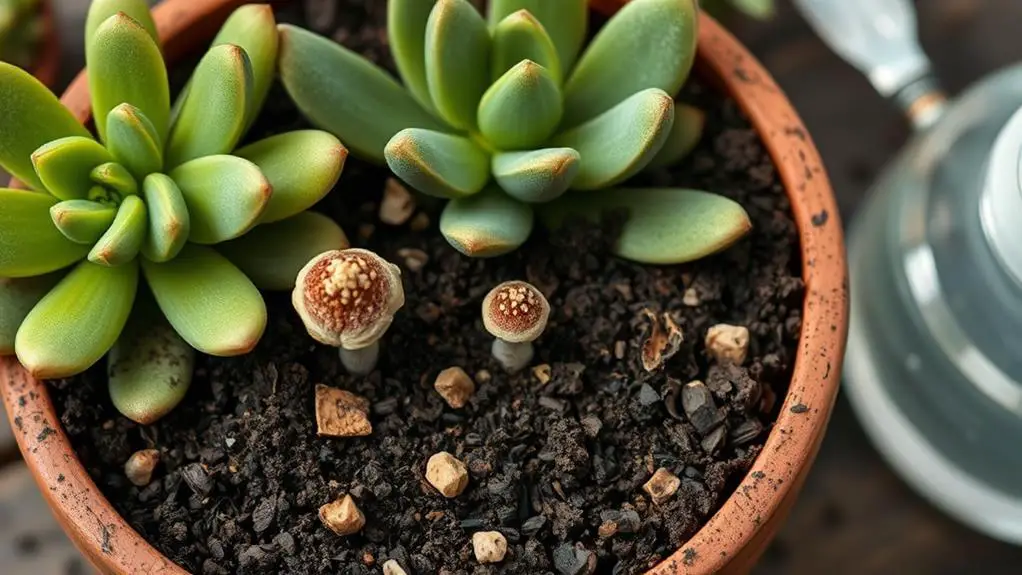
Understanding the environmental factors that contribute to mushroom growth in your succulent pots is just the beginning. To effectively manage your soil and keep those pesky mushrooms at bay, you'll need to focus on several key areas.
First, use a well-draining soil mix specifically formulated for succulents. This type of soil prevents excess moisture retention, which can foster mushroom growth. Check the drainage holes in your pots regularly. Clear holes allow proper water escape, reducing the risk of water accumulation.
Water your succulents only when the top inch of soil feels dry to the touch. This helps maintain ideal moisture levels and discourages fungal development. Additionally, repotting your succulents every couple of years with fresh potting mix can refresh soil nutrients and reduce the buildup of organic matter that attracts fungi.
Incorporating materials like perlite or coarse sand into your soil mix can enhance aeration and drainage. This creates an environment less conducive to mushroom growth.
Here's a table to summarize these tips:
| Tip | Action | Benefit |
|---|---|---|
| Use well-draining soil mix | Formulated for succulents | Prevents excess moisture |
| Check drainage holes | Regularly clear | Reduces water accumulation |
| Water wisely | When top inch is dry | Maintains ideal moisture |
| Repot every few years | Fresh potting mix | Refreshes nutrients, reduces fungi |
Monitoring Plant Health
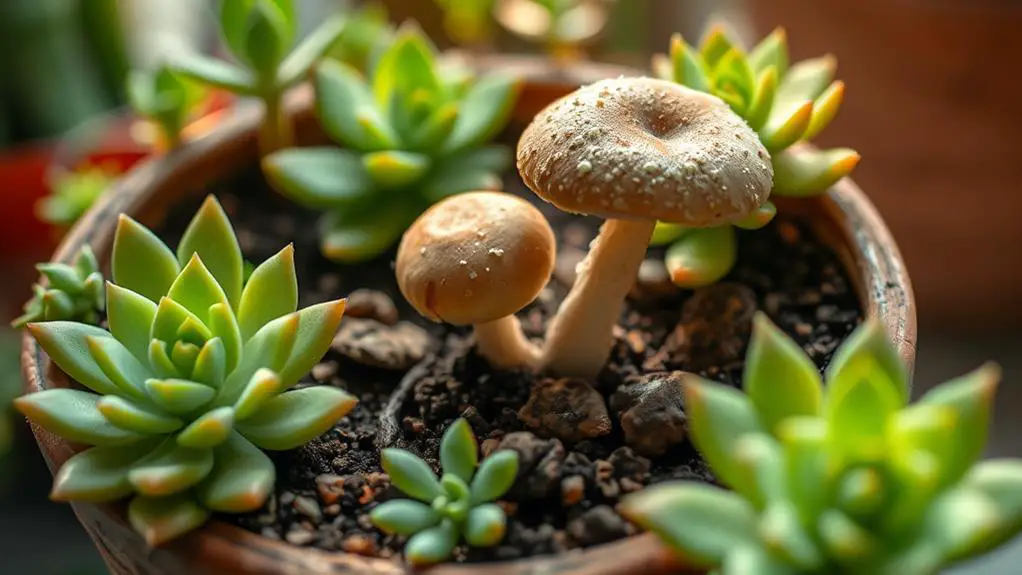
Keeping an eye on your succulents is essential for maintaining their health and preventing issues like mushroom growth. Regularly inspect your plants for signs of distress, such as yellowing leaves or wilting, which can indicate root rot caused by too much moisture.
By monitoring soil moisture, you can guarantee your succulents thrive in well-drained conditions. Water only when the soil is dry to avoid creating an environment where mushrooms can grow.
Observing mushrooms in your succulent pot can be a warning sign that something isn't right. Take immediate action by evaluating your watering habits and checking the drainage of your soil.
Here are three key steps to help you:
- Monitor soil moisture: Use a moisture meter or simply feel the soil with your fingers. Keep it dry between waterings.
- Watch for signs of distress: Look for yellowing leaves or wilting, which might signal root rot or overwatering.
- Record watering schedules: Keep track of when and how much you water. Adjust based on your plant's needs.
Community Insights

Over the years, succulent enthusiasts have shared their experiences with mushroom growth in their pots, highlighting the common issue of excess moisture or decaying organic matter.
These community insights can be really helpful for understanding why mushrooms appear and how to manage them.
Many gardeners stress the importance of soil management. Using well-draining potting mixes is key to preventing excess moisture, which can lead to mushroom growth.
It's also important to monitor soil moisture levels closely. This means checking the soil regularly to verify it's not too wet, as succulents prefer drier conditions.
Opinions on whether you should remove mushrooms vary. Some gardeners believe mushrooms are a natural part of the ecosystem and leave them alone.
Others prefer to remove them for a cleaner look. Either way, the presence of mushrooms can indicate something about your soil health.
It might mean there's decaying organic matter or too much moisture, both of which need addressing.
Frequently Asked Questions
Why Is My Succulent Growing a Mushroom?
Your succulent's growing a mushroom because the soil's too moist. Mushrooms thrive in damp, organic-rich environments. Check your pot's drainage and soil health. Guarantee proper watering and ventilation to prevent future mushroom growth and protect your plant.
Why Are My Succulents Getting Fungus?
Your succulents are getting fungus because the soil is too moist, often due to poor drainage. Excessive moisture and organic matter create a perfect environment for fungi. Regularly check soil moisture and guarantee proper drainage to prevent this.
Is Mushroom Soil Good for Succulents?
Mushroom soil isn't good for succulents. It retains too much moisture and has too much organic matter, leading to root rot. Instead, use a well-draining mix designed for succulents to keep them healthy.
Conclusion
Don't worry if you see mushrooms in your succulent pot—they're a sign to check your watering habits and soil conditions. By using well-draining soil, avoiding overwatering, and ensuring proper drainage, you can keep your succulents healthy. Remember, it's all about balance. Monitor your plants regularly and adjust as needed. With these tips, you'll prevent mushroom growth and help your succulents thrive. Keep going; you've got this! Happy gardening!

